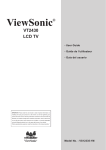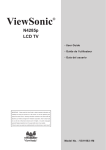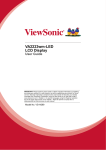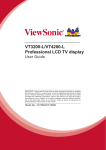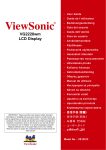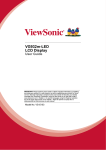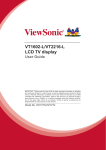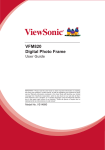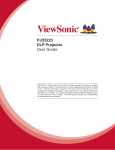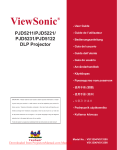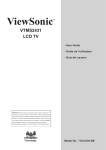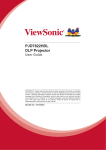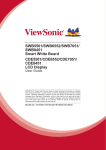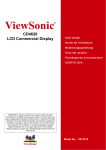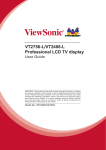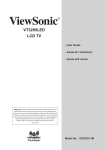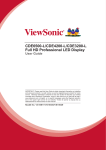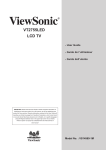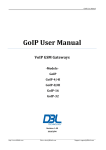Download CDE6501LED LED Display - CNET Content Solutions
Transcript
CDE6501LED LED Display User Guide IMPORTANT: Please read this User Guide to obtain important information on installing and using your product in a safe manner, as well as registering your product for future service. Warranty information contained in this User Guide will describe your limited coverage from ViewSonic Corporation, which is also found on our web site at http://www. viewsonic.com in English, or in specific languages using the Regional selection box in the upper right corner of our website. “Antes de operar su equipo lea cu idadosamente las instrucciones en este manual” Model No. VS15026 Contents Compliance Information.............................................................................. i Copyright Information.................................................................................ii Important Information...............................................................................iii Important Safety Precautions....................................................................iv Important Notice......................................................................................viii Getting Started Package contents.............................................................................................1 Installing the stand...........................................................................................2 Preventing the Display from toppling over.....................................................3 Front view of the Display................................................................................4 Back view of the Display.................................................................................5 Remote control...............................................................................................6 Selecting a location . .......................................................................................7 Installing remote control batteries..................................................................7 Aiming the remote control..............................................................................8 Connections................................................................................................. 9 Basic Operations........................................................................................13 Adjusting the Picture.................................................................................15 Adjusting the Sound..................................................................................17 Adjusting Basic Settings............................................................................18 Setting Clock & Timer...............................................................................19 Setting Lock Menu.................................................................................... 22 Setting Hotel Mode................................................................................... 23 Using USB Multi Media Player................................................................. 24 Other Information Troubleshooting............................................................................................34 Specifications................................................................................................. 35 RS232 Command Table.................................................................................36 Customer Support........................................................................................46 Limited Warranty.......................................................................................... 47 Mexico Limited Warranty.............................................................................48 Compliance Information FCC Statement This device complies with part 15 of FCC Rules. Operation is subject to the following two conditions: (1) this device may not cause harmful interference, and (2) this device must accept any interference received, including interference that may cause undesired operation. This equipment has been tested and found to comply with the limits for a Class B digital device, pursuant to part 15 of the FCC Rules. These limits are designed to provide reasonable protection against harmful interference in a residential installation. This equipment generates, uses, and can radiate radio frequency energy, and if not installed and used in accordance with the instructions, may cause harmful interference to radio communications. However, there is no guarantee that interference will not occur in a particular installation. If this equipment does cause harmful interference to radio or television reception, which can be determined by turning the equipment off and on, the user is encouraged to try to correct the interference by one or more of the following measures: •Reorient or relocate the receiving antenna. •Increase the separation between the equipment and receiver. •Connect the equipment into an outlet on a circuit different from that to which the receiver is connected. •Consult the dealer or an experienced radio/TV technician for help. Warning: You are cautioned that changes or modifications not expressly approved by the party responsible for compliance could void your authority to operate the equipment. Following information is only for EU-member states: The mark shown to the right is in compliance with the Waste Electrical and Electronic Equipment Directive 2002/96/EC (WEEE). The mark indicates the requirement NOT to dispose the equipment as unsorted municipal waste, but use the return and collection systems according to local law. If the batteries, accumulators and button cells included with this equipment,display the chemical symbol Hg, Cd, or Pb, then it means that the battery has a heavy metal content of more than 0.0005% Mercury or more than,0.002% Cadmium, or more than 0.004% Lead. i Copyright Information Copyright © ViewSonic® Corporation, 2012. All rights reserved. ViewSonic, the three birds logo, OnView, ViewMatch, and ViewMeter are registered trademarks of ViewSonic Corporation. Disclaimer: ViewSonic Corporation shall not be liable for technical or editorial errors or omissions contained herein; nor for incidental or consequential damages resulting from furnishing this material, or the performance or use of this product. In the interest of continuing product improvement, ViewSonic Corporation reserves the right to change product specifications without notice. Information in this document may change without notice. No part of this document may be copied, reproduced, or transmitted by any means, for any purpose without prior written permission from ViewSonic Corporation. Product Registration To meet your future needs, and to receive any additional product information as it becomes available, please register your product on the Internet at: www.viewsonic.com. For Your Records Product Name: CDE6501LED ViewSonic LED Display Model Number: VS15026 Document Number: CDE6501LED_UG_ENG Rev. 1A 09-10-12 Serial Number: Purchase Date: Product disposal at end of product life ViewSonic respects the environment and is committed to working and living green. Thank you for being part of Smarter, Greener Computing. Please visit ViewSonic website to learn more. USA & Canada:http://www.viewsonic.com/company/green/recycle-program/ Europe: http://www.viewsoniceurope.com/uk/support/recycling-information/ Taiwan: http://recycle.epa.gov.tw/recycle/index2.aspx ii Important Information WARNING: TO REDUCE THE RISK OF FIRE OR ELECTRIC SHOCK, DO NOT EXPOSE THIS APPARATUS TO RAIN OR MOISTURE. CAUTION RISK OF ELECTRIC SHOCK DO NOT OPEN CAUTION -To reduce the risk of electric shock, do not perform any servicing other than that contained in the operating instructions unless you are qualified to do so. The lightning flash with arrowhead symbol,within an equilateral triangle is intended to alert the user to the presence of uninsulated dangerous voltage within the product's enclosure that may be of sufficient magnitude to constitute a risk of electric shock to persons. The exclamation point within an equilateral triangle is intended to alert the user to the presence of important operating and maintenance (servicing) instructions in the literature accompanying the appliance. iii Important Safety Precautions Electrical energy can perform many useful functions, but it can also cause personal injuries and property damage if improperly handled. This product has been engineered and manufactured with the highest priority on safety. But IMPROPER USE CAN RESULT IN POTENTIAL ELECTRICAL SHOCK OR FIRE HAZARD. In order to prevent potential danger, please observe the following instructions when installing, operating and cleaning the product. To ensure your safety and prolong the service life of your product, please read the following precautions carefully before using the product. 1. Read these instructions --- All operating instructions must be read and understood before the product is operated. 2. Keep these instructions --- These safety and operating instructions must be kept in a safe place for future reference. 3. Heed all warnings --- All warnings on the product and in the instructions must be observed closely. 4. Follow all instructions --- All operating instructions must be followed. 5. Do not use this apparatus near water --- for example, near a bathtub, washbowl, kitchen sink, or laundry tub, in a wet basement, or near a swimming pool, and the like. Do not use immediately after moving from a low temperature to high temperature environment, as this causes condensation, which may result in fire, electric shock, or other hazards.The apparatus shall not be exposed to dripping or splashing and that no objects filled with liquids, such as vases, shall be placed on the apparatus. 6. Clean only with dry cloth --- Unplug this product from the wall outlet before cleaning. Do not use liquid cleaners or aerosol cleaners. Use a damp cloth for cleaning. 7. Ventilation --- Do not block any ventilation openings. Install in accordance with the manufacturer instructions. The vents and other openings in the cabinet are designed for ventilation. Do not cover or block these vents and openings since insufficient ventilation can cause overheating and/or shorten the life of the product. Do not place the product on a bed, sofa, rug or other similar surface, since they can block ventilation openings. This product is not designed for built-in installation; do not place the product in an enclosed place such as a bookcase or rack, unless proper ventilation is provided or the manufacturer’s instructions are followed. iv Important Safety Precautions (Continued) 8. Heat sources --- Do not install near any heat sources such as radiators, heat registers, stoves, or other apparatus (including amplifiers) that produce heat. 9. Grounding or Polarization --- Do not defeat the safety purpose of the polarized or grounding-type plug. A polarized plug has two blades with one wider than the other. A grounding type plug has two blades and a third grounding prong. The wide blade or the third prong are provided for your safety. If the provided plug does not fit into your outlet, consult an electrician for replacement of the obsolete outlet. 10.Power cord protection --- Protect the power cord from being walked on or pinched particularly at plugs, convenience receptacles, and the point where they exit from the apparatus. NOTE: where the mains plug or an appliance coupler is used as the disconnect device, the disconnect device shall remain readily operable. 11.Attachments --- Only use attachments/accessories specified by the manufacturer.Do not use attachments not recommended by the manufacturer. Use of improper attachments can result in accidents. 12.Stand --- Use only with the cart, stand, tripod, bracket, or table specified by the manufacturer, or sold with the apparatus. Do not place the product on an unstable trolley, stand, tripod or table. Placing the product on an unstable base can cause the product to fall, resulting in serious personal injuries as well as damage to the product. When mounting the product on a wall, be sure to follow the manufacturer’s instructions. Use only the mounting hardware recommended by the manufacturer. 13.Move carefully --- When a cart is used, use caution when moving the cart/apparatus combination to avoid injury from tip-over. Sudden stops, excessive force and uneven floor surfaces can cause the product to fall from the trolley. Never attempt to move the Display unless the AC power cord has been disconnected. 14.Lightning --- Unplug this equipment during lightning storms or when unused for long periods of time.For added protection for this equipment during a lightning storm, or when it is left unattended and unused for long periods of time, unplug it from the wall outlet. This will prevent damage to the equipment due to lightning and power-line surges. v Important Safety Precautions (Continued) 15.Servicing --- Refer all servicing to qualified service personnel. Servicing is required when the apparatus has been damaged in any way, such as power-supply cord or plug is damaged, liquid has been spilled or objects have fallen into the apparatus, the apparatus has been exposed to rain or moisture, does not operate normally, or has been dropped. 16.Replacement parts --- In case the product needs replacement parts, make sure that the service person uses replacement parts specified by the manufacturer, or those with the same characteristics and performance as the original parts. Use of unauthorized parts can result in fire, electric shock and/or other danger. 17.Overloading --- Do not overload wall outlets, extension cords, or convenience receptacles on other equipment as this can result in a risk of fire or electric shock. 18.Entering of objects and liquids --- Never insert an object into the product through vents or openings. High voltage flows in the product, and inserting an object can cause electric shock and/or short internal parts. For the same reason, do not spill water or liquid on the product. 19.Damage requiring service --- If any of the following conditions occurs, unplug the power cord from the AC outlet, and request a qualified service person to perform repairs. a. When the power cord or plug is damaged. b. When a liquid is spilled on the product or when objects have fallen into the product. c. When the product has been exposed to rain or water. d. When the product does not operate properly as described in the operating instructions. Do not touch the controls other than those described in the operating instructions.Improper adjustment of controls not described in the instructions can cause damage,which often requires extensive adjustment work by a qualified technician. e. If the product has been dropped or the cabinet has been damaged in any way. f. When the product displays an abnormal condition or exhibits a distinct change in performance. Any noticeable abnormality in the product indicates that the product needs servicing. 20.Safety checks --- Upon completion of service or repair work, request the service technician to perform safety checks to ensure that the product is in proper operating condition. 21.Wall or ceiling mounting --- When mounting the product on a wall or ceiling, be sure to install the product according to the method recommended by the manufacturer. This is a safety feature. Note: Before mounting the product on the wall or ceiling, connect the cables between the corresponding jacks on the product and the external device first. vi Important Safety Precautions (Continued) 22.Power source --- This product is intended to be supplied by a listed power supply indicated on the marking label. If you are not sure of the type of power supply to your home, consult your product dealer or local power company. For added protection for this product during a lightning storm, or when it is left unattended and unused for long periods of time, unplug it from the wall outlet and disconnect the cable system. This will prevent damage to the product due to lightning and power line surges. When the Display has to be used with another power supply voltage, the power cable must be changed. Consult your product dealer. The socket outlet should be installed near the equipment and easily accessible. Use only the power cord designated by our dealer to ensure safety and EMC. When connecting other products such as VCRs and personal computers, you should turn off the power of the Display for protection against electric shock. 23.Panel protection --- The display panel used in this product is made of glass. Therefore, it can break when the product is dropped or impacted upon by other objects. Be careful not to be injured by broken glass pieces in case the display panel breaks. 24.Pixel defect --- The display panel is a very high technology product, giving you finely detailed pictures. Occasionally, a few non-active pixels may appear on the screen as a fixed point of blue, green or red. Please note that this does not affect the performance of your product. WARNING: •For continued safety, apparatus with class I construction shall be connected to a mains socket outlet with a protective earthing connection. •To prevent the spread of fire, keep candles or other open flames away from this product at all times. vii Important Notice About Location/ Environment About After-Image Do not use in hot and cold rooms (locations) •When the Display is used in rooms (locations) with low temperature, the picture may leave trails or appear slightly delayed. This is not a malfunction, and the Display will recover when the temperature returns to normal. •Do not leave the Display in a hot or cold location. Also, do not leave the Display in a location exposed to direct sunlight or near a heater, or in high humidity, as this may cause the cabinet to deform and the screen to malfunction, and affect the Display’s performance . •Environment condition: Operating temperature: 5°C – 35°C Operating humidity: 20 – 80 % ( no moisture condensation ) Storage temperature: 0°C – 45°C Storage humidity: 10 – 80 % Atmospheric pressure: 86 kPa ~106 kPa The extended use of fixed image programme material can cause a permanent after-image on the screen. This background image is viewable on normal programs in the form of a stationary fixed image. This type of irreversible screen deterioration can be limited by observing the following steps: A. Reduce the brightness/contrast setting to a minimum viewing level. B. Do not display the fixed image for extended periods of time. C. Turn the power off when not in actual use. Important Information Regarding Use of Video Games, Computers, Captions or Other Fixed Image Displays. •Do not allow a still picture to be displayed for an extended period, as this can cause a permanent afterimage to remain on the screen.Examples of still pictures include logos, video games, computer images and images displayed in 4:3 mode. CAUTIONS: •The permanent after-image on the screen resulting from fixed image use is not an operating defect and as such is not covered by the warranty. •This product is not designed to display fixed images for extended periods of time. viii Important Notice (Continued) Cleaning and Maintenance To clean this Display, wipe with a soft, dry cloth. If the surfaces are extremely dirty, use a soft cloth dipped in a soap and water solution or a weak detergent solution. •Use eyeglass cleaner to remove stubborn dirt from the screen. •Never use alcohol, paint thinner or benzine to clean this Display. •Before using a chemically treated cloth, read the instructions that came with the cloth carefully. ix Getting Started Package contents 1. The Display 4. Quick Setup Guide 2. Remote control and two AAA batteries 5.Stand 1 3. User Guide Getting Started (Continued) Installing the stand If the stand is provided, please read these instructions thoroughly before attempting this installation. You must install your Display into the stand in order for it to stand upright on a cabinet or other flat surface. If you intend to mount your Display on a wall or other vertical surface, you must remove the stand column. Cautions: •Make sure that you handle your Display very carefully when attempting assembly or removal of the stand. If you are not sure of your ability to do this, or of your ability to use the tools necessary to complete this job, refer to a professional installer or service personnel. The manufacturer is not responsible for any damages or injuries that occur due to mishandling or improper assembly. •When using a table or bench as an aid to assembly, make sure that you put down a soft cushion or covering to prevent accidental scratching or damage to your Display’s finish. •The speaker is not intended to support the weight of your Display. Do not move or handle your Display by the speaker. This can cause damage to your Display that is not covered by the manufacturer’s warranty. •Before attempting assembly or removal of the stand, unplug the AC power cord. To install the stand: 1. Remove the stand from the box and place it on a table or bench. You must pay attention to the direction of the stand. The wide portion of the Locating grooves Secure with stand should go towards the front of the four screws Stand Column Display. Locators 2. Lay your Display flat (screen down) on Secure with the edge of a table or bench. Make sure five screws Stand that you put down a soft cushion or cloth so that yourDisplay is not scratched. 3. Put the stand column close to the back of the Display, align the locating grooves on the stand column with the Locators on the Display, and align the screw holes on the stand column with the holes on the Display, then secure the stand column to the Display with four provided screws. 4. Align the screw holes on the stand column with the holes in the stand, then secure the stand to the Stand column with five provided screws. After stand installation, if you find the stand is not stable horizontally,please do the following: Place the Display face-down on a cushioned surface, loosen the four screws securing the set to its stand column (note that only loosen a little, not detach the screws),then tilt the column toward lower position, then tighten these screws again. Note: 1. The appearance of this product in these illustrations may differ from your actual product,and is for comparative purposes only. 2. We may change the design and specifications without notice. 2 Getting Started (Continued) Preventing the Display from toppling over There is a chance that the Display may topple over in the event of an earthquake or child climbing, etc. Take measures to prevent it from toppling over for safety's sake. For example, secure the Display to the wall or pillar as shown at below figures. Fig.1 Fig.2 Secure the Display to the wall by string, etc. retaining ring wall mounting hole on the Display’s back Pass the string through the retaining ring. Use screw to fix. Note: The parts such as string, retaining ring, screws used to secure the Display to the wall or pillar are not provided. You may purchase them from sales store. The parts may differ from actual ones, and are for comparative purposes only. 3 Getting Started (Continued) Front view of the Display Item 1. Remote Sensor 2. Indicator 3. Power 4. INPUT 5. MENU 6. 7. VOL -/+ Description Receives signals from the remote control. Do not block. Lights blue when your Display is turned on. Lights red when your Display is in standby mode. Off when power cord is unplugged. Press to turn the Display ON from STANDBY mode. Press it again to turn the set back to STANDBY. Press to access Input Source menu. Press to open the MENU main page; In OSD menu,press to return to the previous menu or close the menu. In menu operations, these buttons serve as down/up buttons. Press the VOL+ or VOL- button to directly increase or decrease the sound volume level; In menu operations,these buttons serve as right/left buttons. Note: 1. Functions of POWER , INPUT, MENU, / and VOL+/- are also provided to the remote control. This operation manual provides a description based on operating functions with the remote control. 2. Buttons on the Display are touch buttons. First touch of the button will illuminate it. Second touch will fulfill its function. Ensure that the button is pressed quickly before the illumination disappears. It is suggested to push the center of the sensor, otherwise the operation may not be fulfilled successfully. 4 Getting Started (Continued) Back view of the Display Description For service use . The user cannot operate the Display through this terminal. 2.HDMI1/2/3 interface To connect with those equipments with HDMI or DVI interface, for example, Set-top box or DVD player. (A HDMI-to-DVI adapter cable is required when you are connecting a DVI-equipped device to this Display.) 3. PC input Connect to the D-Sub/AUDIO output jack on your computer. 4. COMPONENT inputs Connect to the audio and component output jacks of a DVD player or Set-Top Box. 5. Remote Control Out IR pass through. 6.S/PDIF digital audio Connect to the digital audio input of a digital audio out terminal component. 7. USB port Connect a USB device to this port. 8.Headphone jack Connect to your headphones. 9. AV inputs Receive video/audio signal from external sources such as (Video,Audio L, R) VCR or DVD player. Item 1. RS-232 interface 5 Getting Started (Continued) Remote control Button Description 1. INPUT Displays Input Source menu. 2.0 – 9 number Press to input password. buttons Press the arrows to navigate 3. / / / / through the menus or adjust OK an item. Press OK to confirm a selection or enter a submenu. 4. MUTE Mutes the sound. 5. PICTURE Selects picture mode. 6.VOL+/- Increases or decreases the volume. Selects sound mode 7. SOUND 8.USB control buttons 9. Power 10. EXIT 11. MENU 12.INFO 13. ASPECT : Play / pause button. : Stop button. : Plays the previous. : Plays the next. Switches the Display power on or Standby. Exits the menu screen. Open the main menu or return to the previous menu. Displays the information banner. Selects the screen size. Note: Those buttons which are not described above have no function in this model. 6 Getting Started (Continued) Selecting a location You should select a location for the Display: ·Where direct light does not reflect on the screen. ·That has indirect and soft lighting. ·Where the Display has access to a power outlet. Note: Watching in total darkness or with a reflection on the screen may cause eyestrain. Installing remote control batteries To install remote control batteries: 1 Open the battery cover. 2 Insert two AAA batteries into the battery compartment. Make sure that the + and – symbols on the batteries match the + and – symbols in the battery compartment. 3 Replace the cover. Battery precautions: Improper use of batteries can result in a leakage of chemicals and/or explosion. Be sure to follow the instructions below. •Place batteries with their terminals corresponding to the (+) and (–) indications. •Different types of batteries have different characteristics. Do not mix batteries of different types. •Do not mix old and new batteries. Mixing old and new batteries can shorten the life of new batteries and/or cause old batteries to leak chemicals. •Remove batteries as soon as they are non-operable. Chemicals that leak from batteries can cause a rash. If chemical leakage is found, wipe with a cloth. •Dispose of batteries in a proper manner. •If the remote control is not used for an extended period of time, remove the batteries. •The batteries shall not be exposed to excessive heat such as sunshine, fire or the like. 7 Getting Started (Continued) Aiming the remote control Use the remote control by pointing it towards the remote sensor on the front of your Display. Objects between the remote control and the remote sensor may prevent proper operation. Cautions regarding use of remote control •Do not expose the remote control to shock. In addition, do not expose the remote control to liquids, and do not place in an area with high humidity. •Do not install or place the remote control under direct sunlight. The heat may cause deformation of the Display. •The remote control may not work properly if the remote sensor window of the main Display is under direct sunlight or strong lighting. In such a case, change the angle of the lighting or the set, or operate the remote control closer to the remote sensor window. 8 Connections Cautions Before Connecting •When connecting an external device to the Display, make sure that the Display and the device are turned off. •Check the plugs on the ends of cables to make sure that they are the correct type before you try plugging them into jacks on the Display. •Make sure that all plugs are securely inserted into the jacks. Loose connections can result in image or color problems. •The illustration of the external device may be different depending on your model. •Refer to the operating manual of the external device as well. Connecting power Plug the AC power cord into a power outlet. Note: •This Display should be operated only from the type of power source indicated on the marking label. •Always unplug the AC cord from power outlet when not using for a long period of time. •This illustration is for reference only. The AC plug may be different on different models. Household power outlet AC cord Connecting digital sound system Display Side For a full Home Theater sound experience,you must connect your digital sound system to the S/PDIF OUT jack on the Display. To connect a home theater system using a digital audio cable: Digital sound system Connect one end of a digital audio cable to the S/PDIF jack on the Display.Connect the other end of the digital audio cable to the S/ PDIF jack on the digital audio system. S/PDIF IN 9 Connections (Continued) Connecting Headphones Display Side To connect headphones: Insert the plug of the headphone into the Display’s Headphone jack. When using headphones, adjust the headphone volume so as to avoid excessive levels as hearing damage may result Headphones Connecting a USB storage device Insert your USB device into the USB port To play from the USB device: 1. Turn on your Display, then press INPUT button. The Input Source menu opens To USB port 2. Press or to select USB, then press OK to confirm. Never remove the USB device or turn off the Display while using the USB device. Display Side Connecting AV device (for playback) VCR or Display Side Camcorder AV cable or Game console Cables are often colorcoded to connectors. Connect yellow to yellow, red to red, white to white. To connect an AV device (such as VCR, camcorder, or game console) : Connect the Audio/Video cables between the Audio (L/R)/Video jacks on the Display and AV device. 1. Turn on your Display, then press INPUT button. The Input Source menu opens. 2. Press or to select AV, then press OK to confirm. 3. Turn on your AV device , insert a videotape and press the Play button. 10 Connections (Continued) Connecting HDMI device Display Rear HDMI cable How to connect an HDMI device: Connect the HDMI cable between the HDMI jack on the Display (HDMI1 and HDMI2 located at the rear, while HDMI3 at the side) and HDMI output jack on the device. Note: If your device has an HDMI connection, we recommend you use that to get the best quality possible To play from the HDMI device: HDMI device 1. Turn on your Display, then press INPUT button. The Input Source menu opens. 2. Press or to select HDMI1 or HDMI2 or HDMI3 correspondingly, then press OK to confirm. 3. Turn on the HDMI device and set it to the correct mode. Refer to the instructions that came with the HDMI device. Note: If the external device has DVI output only, use a DVI to HDMI adapter cable to connect to the HDMI terminal. Connect the audio cable to the PC IN AUDIO jack on the Display rear. Connecting component Video device DVD Player, etc. Component video cable Audio cable Display Rear Component cables often have red, green, and blue colorcoded video connectors and red and white audio connectors. Match the colors when making connections. To connect a component video device: Connect the Component Video cable between the Y, PB, PR input jacks on the Display and Y, PB, PR output jacks on the device .Connect the Audio cable between the AUDIO input jacks on the Display and AUDIO output jacks on the device. To play from the component video device: 1. Turn on your Display, then press INPUT button. The Input Source menu opens. 2. Press or to select Component, then press OK to confirm. 3. Turn on your external device and set it to the correct mode. See the device’s user guide for more information. 11 Connections (Continued) Connecting computer To connect a computer: Connect a D-SUB(VGA) cable between the D-Sub jack on the computer and the D-Sub input jack on the Display. Connect an Audio cable between the AUDIO output on the computer and AUDIO input jack on the Display To display port (15-pin D-Sub) D-Sub cable To audio output jack Display Rear Audio cable To play video from the computer: 1. Turn on your Display, then press INPUT button. The Input Source menu opens. 2. Press or to select D-SUB, then press OK to confirm. Note: Some computers have an HDMI jack. You 3. Turn on your computer, and can use an HDMI cable to connect the computer for adjust the Display properties as a better picture. required. 12 Basic Operations Turning the Display on or off 1 Make sure that the power cord is connected to a power outlet. 2 Now the Display is in standby mode. Wait some seconds until the power indicator lights up, then press POWER to turn on your Display. (Be sure to wait some seconds before pressing POWER button. If you promptly press POWER button then the Display may not respond or act wrongly.) 3 Press button again to turn off your Display. Your Display enters standby mode. Warning: When the Display is in standby mode, power is still flowing into the Display. For the sake of energy saving and safety issue, please disconnect the power cord to completely cut off the power. After you turn off the Display, you should wait some seconds before you turn it on again. Note: If the Display does not receive a broadcast signal for several minutes, the Display goes into standby mode Selecting the input source To select the input source: 1 Press INPUT button. The Input Source list appears. 2 Press or to select the input source, then press OK or / to confirm your choice. The Display switches to the selected source. Using the OSD menu To operate the OSD (on-screen display) menu: •Press MENU to call up the OSD main menu. –The screen will now display PICTURE menu. • Press or one or more times to select menu, press to access. –PICTURE, SOUND, TIME, OPTION, LOCK menu can be selected. •From the menu, press to navigate or adjust. Press OK to confirm an entry or selection. •To return to previous menu, press MENU. •To close the menu, press EXIT. 13 Basic Operations (Continued) On-screen menu overview PICTURE menu SOUND menu TIME menu OPTION menu LOCK menu Note: •Depending on the signal tuned, you may see different menu options on your screen. •Menu items that are not selectable are grayed out. •The illustrations and on-screen displays in this manual are for explanation purposes (some are enlarged, others cropped) and may vary slightly from the actual ones. Adjusting the volume •Press the VOL+/ – to increase or decrease the volume. •Press the MUTE button to temporarily turn off the sound. To restore the sound, press the MUTE button again. 14 Adjusting the Picture Adjusting the picture To adjust the picture: 1 Press MENU. The on-screen menu opens with the PICTURE menu displayed, then press to access 2 Press to highlight an option, press to adjust the option; If a sub-menu exists, press or OK to access. You can select: •Picture Mode — Selects the picture mode. You can select: .. Dynamic (a bright and vivid picture) .. Standard (a standard picture) .. Soft (a soft picture) .. User (user customized picture). Note: You can also press PICTURE on the remote control to select the picture mode. •Contrast — Adjusts the contrast. •Brightness — Adjusts the brightness. •Colour — Adjusts the colour saturation. •Sharpness — Adjusts the sharpness. •Tint — Adjusts the image tint. (Only for NTSC system) •Backlight — Sets the overall brilliance of the screen. •Colour Temperature — Selects the colour temperature. You can select Warm (to enhance the reds), Cool (to enhance the blues), or Normal. •Aspect Ratio — Selects the aspect ratio of the picture. You can select: .. 16:9 — Shows a full-screen picture in 16:9 mode. .. 4:3 — Shows picture in 4:3 display mode. (Recommended not let the Display remain in this mode for extended period of time as to protect the screen.) .. Auto — Selects the correct aspect ratio automatically. (Note: In Component mode, due to technology limited, for 480i/p,576i/p “16:9” signal, please select “16:9” aspect ratio manually) .. Zoom1 — Enlarges the picture vertically. The top and bottom may be cropped. .. Zoom2 — Enlarges picture both horizontally and vertically. The edges may be cropped. .. 1:1 pixel mapping (D-SUB, HDMI, Component only) — Displays an input source without scaling it (This option is available when native resolution is 1920x1080 and input resolution is 1920 x 1080p) Note: You can also press ASPECT to select the aspect ratio. 15 Adjusting the Picture (Continued) •Noise Reduction — Selects the noise reduction mode to reduce picture noise (snow). You can select Low, Middle, High, or Off. •Overscan (D-SUB, HDMI only) — Turn this On to adjust the picture’s reproduction rate (available when the input signal is in video format). •Adaptive Contrast — Turn this On to optimize the picture display for a more vivid image. •HDMI Black Level (HDMI only) — Selects the black level on the screen. Select Low for darker screen, Normal for brighter screen. (Available when RGB signal is input through HDMI jack). •Screen (D-SUB only) — Adjusts the computer image. Adjusting the computer image Before adjusting the screen, make sure that you select the correct source (D-SUB). To adjust the computer image: 1 Press MENU. The on-screen menu opens with PICTURE menu displayed. 2 Press or repeatedly to scroll the menu page until you select the Screen item, then press or OK to access. 3 Press or to highlight an option,press or to adjust the level, or press OK to confirm. You can select: •Auto Adjust — Automatically adjusts the image settings such as position and phase. •Horizontal Pos. — Moves the image right or left. •Vertical Pos. — Moves the image up or down. •Size — Adjust the horizontal width of the image on the screen. •Phase — Adjusts the focus of stable images. 4 To close the menu, press EXIT button. 16 Adjusting the Sound Adjusting the sound To adjust the sound: 1 Press MENU. The on-screen menu opens. 2 Press or to select SOUND menu,press to access. 3 Press or to highlight an option, press or to adjust the option. You can select: •Sound Mode — Selects the sound mode. You can select: .. Standard (for normal programs) .. Music (for musical programs) .. Movie (for movies) .. Sports (for sports programs) .. User (for user setting sound mode). Note: You can also press SOUND on the remote control to select the sound mode. •Treble — Adjusts Treble (high sounds). •Bass — Adjusts Bass (low sounds). •Balance — Adjusts the balance between the left and right audio channels. •Auto Volume — Turns On to equalize the overall volume levels for all channels. •Surround Sound — Turns the Surround sound effect on or off. •Visual Impairment — Sets the mix of visually impaired audio with regular audio. When available, visually impaired audio includes audio descriptions of on-screen action. Enable this by setting Mode to On, also you can adjust the volume from this menu. •Headphone Connection — Selects Speaker On if you want the speaker sound keeps normal after the headphone is connected. Selects Speaker Off if you want the speaker sound is muted when the headphone is connected. 4 To close the menu, press EXIT button. 17 Adjusting Basic Settings Adjusting basic settings To adjust basic settings: 1 Press MENU. The on-screen menu opens 2 Press or to display OPTION menu, press to access. 3 Press or to select an option, press or to adjust the option. If a sub-menu exists, press OK to access, then use to select and adjust. •OSD Language — Selects on-screen menus language. •S/PDIF Output (digital only) — Selects the digital audio output mode for S/PDIF. You can select Auto or PCM. .. Auto: This mode outputs Dolby Digital or PCM to the digital audio output jack (S/PDIF) providing it is being broadcast. .. PCM: Select this when a 2ch digital stereo amplifier is connected to the Display. When you select a Dolby Digital or MPEG audio track, the sound is converted to the PCM (2ch) format and output. •Judder Adjustment — When viewing programs, picture problems such as Blur and Judder may occur, and different programs have different amount of Judder. The Judder Adjustment option will help you correct this picture problem by reducing the amount of judder on your Display. You can select Weak/Normal/Strong that suits your taste, select Off to turn off this feature. .. Weak: Select for news programs or similar programs. .. Normal: Select for movie or general programs. .. Strong: Select for sports programs. •Note: Judder Adjustment is available only under certain formats. Sometimes it will be turned off automatically when some OSD displays on the screen, then restore automatically when the OSD disappears. •Audio Only — When listening to MP3 music (through USB music play), you can set Audio Only to Power Saving for energy save. The backlight will turn off automatically after some seconds. Select Normal then the backlight works normally. 4 To close the menu, press EXIT button. 18 Setting Clock & Timer Setting clock To set clock – If the clock is not set, you may set the clock manually. – To set OFF timer/ON timer, you should set the clock first. 1 Press MENU. Press or to display TIME menu, press to access. 2 Press or to select Clock, press or OK to access its setting menu. Within the menu, use or to highlight the Date, Month, Year, Hour or Minute item, and use or to adjust the values. When finished, use or to select Close and press OK to confirm the setting and close this sub-menu. 3 To close the menu, press EXIT button. Setting Off timer To set OFF timer You can set OFF timer to switch the Display to standby at a specified time. Once you set OFF timer, it will effect every day. 1 Press MENU. Press or to display TIME menu, press access. to 2 Press or to select Off Time, press or OK to access its setting menu. 3 Now the Activate item is highlighted automatically, press or to select On to turn on the function (To cancel the function, select Off). 4 After Activate is set to On, press or to select Hour or Minute, press or to adjust the value. 5 When finished, use or to select Close and press OK to confirm the setting and close this sub-menu. 6 To close the menu, press EXIT button. 19 Setting Clock & Timer (Continued) Setting ON timer To set ON timer ON timer feature allows you to set the Display to turn on automatically to a preset source at a certain time and at certain volume. Once you set ON timer,it will effect every day. 1 Press MENU. Press or to display TIME menu, press access. to 2 Press or to select On Time. Press or OK to access the submenu. 3 Now the Activate item is highlighted automatically, press or to select On to enable ON timer (To cancel, select Off ). 4 After Activate is set to On, press or to go through the item list adding the details of the on timer by using or to make selections. •Hour/Minute: Sets the desired time to turn on the Display. •Volume: Sets the volume level for the On Timer program. •Input: Sets the input source to be viewed when the Display turns on. 5 When finished, use or to select Close item and press OK to close the submenu. Press EXIT button to close the main menu. 6 Press to switch the Display to standby mode. At the preset time, the Display will auto turn on and go to the preset source at the preset volume. Setting Sleep timer To set Sleep timer Sleep timer lets you select the amount of time before your Display turns itself off automatically. This setting is cleared when the Display is turned off. 1 Press MENU. Press or to display TIME menu, press 2 Press or to access. to select Sleep Timer. 3 Press or to select the amount of time; to turn off the timer, please select Off. Note: After you have set sleep timer, when the last 60 seconds comes, the Power Off screen will appear to remind you after how many seconds the Display will power off. You can press any button to quit. 20 Setting Clock & Timer (Continued) Setting Auto Sleep To set Auto Sleep Auto Sleep will bring the Display to standby automatically when there is no signal input (except USB) for a certain time 1 Press MENU. Press or to display TIME menu, press 2 Press or to access. to select Auto Sleep. 3 Press or to select On to turn on Auto Sleep. (To cancel the function, select Off.) 4 To close the menu, press EXIT button 21 Setting Lock Menu Setting or changing the password To set or change the password From LOCK menu you can set a new lock password or to change an existing password. By default, the password is 0000 and you should change it. To access LOCK menu, to restore factory default, the child lock password is required. 1 Press MENU. Press or to display LOCK menu, press to access. 2 Now a password is required to input. Use number buttons to input the correct password (the default password is 0000). 3 Press or to select Set Password, and then press or OK button to access its submenu. 4 Use the number buttons to input a new password (4-digit). Input the new password again. Now the new password has been created successfully. Note: Be sure to write down your password and retain it for future use. If you do forget the password, the Display provides a super password “2580”. Please DO NOT let your children know the super password. Restoring factory default To restore factory default Caution: When you restore factory default, all settings including password will be cleared and reset to default (the password is reset to 0000). So make sure you do want to reset the settings to its original factory condition before you perform this operation. 1 Navigate to the LOCK menu and input the correct password to access 2 Press or to select the Restore Factory Default item, and then press or OK A message appears prompting you to confirm again. 3 Press to reset or press to cancel the reset. 4 Press MENU to return to previous menu. Press EXIT to close the menu directly. 22 Setting Hotel Mode Setting Hotel Mode Hotel Mode feature enables you to set maximum volume, set power on input, etc. which is especially useful at Hotel environment. To set Hotel Mode 1 Press MENU button. The main menu opens. 2 Press number buttons: [ 9, 9, 3 ] to access the Hotel Mode screen. Be sure to quickly input the numbers while the main menu is still visible. 3 Within the menu, press or to highlight an option, press or to set or adjust the option. You can select: •Write settings to Display — Writes the settings in USB file to Display. •Volume def. — Sets power-on volume for the Display. •Volume Max — Sets the maximum volume (30–100) for the Display. •Read Settings from Display — Reads the settings from Display store to USB disk. •USB/AV/YPbPr/HDMI 1/HDMI 2/HDMI 3/PC — Sets Enable, you can select USB/AV/YPbPr/HDMI 1/HDMI 2/HDMI 3/D-SUB on the Input Source list. Sets Disable, the USB/AV/YPbPr/HDMI 1/HDMI 2/HDMI 3/D-SUB source on the Input Source list is not selectable and grayed out. •Power on input — Sets one input source to be viewed when the Display is turned on. •Display ID — Sets the ID number for the Display. 4 Press OK to save the setting. Press EXIT to exit the menu screen directly. 23 Using USB Multi Media Player Using USB multi media player You can connect a USB storage device to your Display to view compatible photo, movie, text on the large screen of the Display or play compatible music so that the sound can be output from the Display’s speakers. To use USB multi media player, please go to USB source through Input Source menu by pressing INPUT button. Notes: •Never remove the USB device or turn off the Display while using the USB device. •It is recommended that you back up your USB device data. •The USB menu may vary in different situation. •If you want to pull out the USB device, please exit USB mode first. For instructions on using your USB device, refer to the owner’s manual of your USB device. •Please use English to name your files. Otherwise the file names can not be shown correctly. •Certain types of USB device may not be compatible with this Display. USB multi media interface introduction 1 Connect your USB device. Select USB mode through the Input Source menu, the USB multi media interface (main menu) will appear automatically. 2 Press or to select your desired media, press OK to access. You can select: •PHOTO — Selects to view compatible photos. •MUSIC — Selects to playback compatible music. •MOVIE — Selects to playback compatible movie. •TEXT — Selects to view compatible text 24 Using USB Multi Media Player (Continued) Media 1: Viewing Photos With the photo viewer, you can: •View photos (in JPG, BMP or PNG format). •View photos with background music. •Pan, zoom, and rotate photos. •Mark photos so you can just slide show those marked photos. Note: The photo viewer supports JPG, BMP, PNG format images, but not all JPG, BMP, or PNG files are compatible with the Display due to technical update. Using photo viewer index and Photo Menu Bar To access photo viewer index / Photo Menu Bar 1 Connect your USB device that contains the photo files you want to view, switch to USB mode, the USB main menu will appear automatically. Press or to select PHOTO, press OK to access. 2 Press or to highlight C disk, press OK to open the USB device; if you want to go back, highlight Return and press OK. 3 After you open the USB device, you can use to navigate and select folders or photo files, then press OK to open the highlighted folder or press to start slide show from current photo file. Below we will take it as an example that your desire photo files are contained in a folder. Just highlight this folder and press OK and the Photo Viewer Index appears, which displays thumbnail images of the files stored inside this folder 25 Using USB Multi Media Player (Continued) 4 The following describes how to use the Photo Viewer Index: Return to •To return to root (C: disk), highlight root Path Return and press OK. •To go back to upper level folder, highlight Up Folder and press OK. •To start slide show from your desired photo, highlight this photo then press . •To mark photos so you can just slide show those photos, use to highlight the specific photo then press OK. A check mark appears on it (press OK again to cancel the mark). Repeat this way to create your favourite photo list, then slide show will go among these photos. Return to upper level folder Current page/total pages Mark Thumbnails of photos 5 During slide show, you can make use of Photo Menu Bar to perform many functions. To call out and operate the Photo Menu Bar, just press INFO button during slide show. The Photo Menu Bar is displayed at the bottom screen. Then use to select your desired function icon, press OK to fulfill the function. If the function icon has several options, repeatedly press OK to select it. To clear the Photo Menu Bar, press INFO again. Press continuously for additional options Show information Rotate clockwise Pan Show playlist Rotate counter- Zoom out Play/stop background music Zoom in clockwise Repeat mode selection Previous Stop Play/Pause photo Next photo The following describes every function icon on the Photo Menu Bar or Play/pause. Also you can directly press on the remote control for play/ pause Go to the previous/next photo. Also you can directly press / on the remote control for previous/next photo. Stop and exit. Also you can directly press on the remote control for stop. Repeat mode selection. Highlight this icon, press OK one or more times to select Repeat 1, Repeat All, No Repeat. Play/pause background music. Note: You can make use of it to playback your marked compatible music file as background music during photo slide show. 26 Using USB Multi Media Player (Continued) List of photo files. It will display a list of all marked compatible photo files in current folder. If none marked, then all compatible photo files in this folder .Press to move upward or downward, press OK to start slide show from it. Press EXIT to exit the list. File information. It will display current photo file information. Press EXIT to clear the information. Rotate the photo clockwise/counterclockwise by 90 degree upon every press. Zoom in/zoom out the photo image Pan (left, right, up, down). You can use Pan only when the photo is magnified using ZOOM. After you highlight this icon and press OK, a symbol appears at the screen’s bottom right corner, now you can press to pan around the photo. Media 2: Playing Music With the USB music player, you can: •Play music bit rate up to 192kbps. •Mark music files so you can just play back those music files. Music Playback To access music playback window 1 Connect your USB device that contains the music files you want to play, switch to USB mode through the Input Source menu, the USB main menu will appear automatically. Press or to select MUSIC, and press OK to access 2 Press or to highlight C disk, then press OK to open the USB device; if you want to go back, highlight Return and press OK. 3 After you open the USB device, you can use to navigate and select folders or music files, then press OK to open the highlighted folder or press to start music play from current music file. Below we will take it as an example that your desire music files are contained in a folder. Just highlight this folder and press OK to open it. All your music files are shown in a thumbnail index 27 Using USB Multi Media Player (Continued) 4 The following describes how to use the music thumbnail Index: •To return to root, highlight Return and press OK. •To go back to upper level folder, highlight Up Folder and press OK. •To start playback from your desired music file, highlight this file then press . •To mark music files so you can just play those music files, use to highlight this music then press OK. A check mark appears on it (press OK again to cancel the mark). Repeat this way to create your favourite music list, then music playback will go among these files. 5 During music playback, you can make use of Music Menu Bar to perform many functions. To call out and operate the Music Menu Bar, just press INFO button during music playback. The Music Menu Bar is displayed at the bottom screen. Then use to select your desired function icon, press OK to fulfill the function. If the function icon has several options, repeatedly press OK to select it. To clear the Music Menu Bar, press INFO again. Press continuously for additional options Fast reverse Previous Stop Repeat Mute Play/Pause Next Fast forward Show playlist Information Skip to specific point by input time The following describes every function icon on the Music Menu Bar. or Play/pause. Also you can directly press pause on the remote control for play/ Fast reverse/fast forward. Go to the previous/next file. Also you can directly press / on the remote control for previous/next file. Stop playback and exit. Also you can directly press on the remote control for stop. Repeat mode selection. Highlight this icon, press OK one or more times to select Repeat 1, Repeat All, No Repeat. 28 Using USB Multi Media Player (Continued) Mute the sound. Also you can press MUTE button on the remote for mute. List of music files. It will display a list of all marked compatible music files in current folder; if none marked, then all compatible music files in this folder. Press to move upward or downward, press OK to start music playback from it. Press EXIT to exit the list. File information. It will display current music file information. Press EXIT to exit. Skip to specific point by input time. Highlight this icon, press OK to call out Input search time screen, use number buttons to input time, use to move the cursor, then highlight OK and press OK button for time search, and the playback starts from the specific time. Note: If you want to show the associated lyrics on the screen with the music, you must store these associated lyrics in the same folder using the same file name with “ .lrc ” file extensions. Media 3: Playing Movie With the USB movie player, you can: •Play movie resolution up to 1080p. •Repeat playing any specified section (AB Loop). •Mark movie files so you can just play back those movie files. Movie Playback To access movie playback window 1 Connect your USB device that contains the movie files you want to play, switch to USB mode through the Input Source menu, the USB main menu will appear automatically. Press or to select MOVIE, and press OK to access. 2 Press or to highlight C disk, then press OK to open the USB device; if you want to go back, highlight Return and press OK. 29 Using USB Multi Media Player (Continued) 3 After you open the USB device, you can use to navigate and select folders or movie files, then press OK to open the highlighted folder or press to start movie playback from current movie file. Below we will take it as an example that your desire movie files are contained in a folder. Just highlight this folder and press OK to open it. All your movie files are shown in a thumbnail index. 4 The following describes how to use the movie thumbnail Index: •To return to root, highlight Return and press OK. •To go back to upper level folder, highlight Up Folder and press OK. •To start playback from your desired movie file, highlight this file then press . •To mark movie files so you can just playback those movie files, use to highlight this movie file then press OK. A check mark appears on it (press OK again to cancel the mark). Repeat this way to create your favourite movie list, then movie playback will go among these files. 5 During movie playback, you can make use of Movie Menu Bar to perform many functions. To call out and operate the Movie Menu Bar, just press INFO button during movie playback. The Movie Menu Bar is displayed at the bottom screen. Then use to select your desired function icon, press OK to fulfill the function. If the function icon has several options, repeatedly press OK to select it. To clear the Movie Menu Bar, press INFO again. Press continuously for additional options Information Slow motion Zoom in Picture size Show playlist Speed down Time search Zoom out Fast reverse Previous Stop A-B Loop Play/Pause Fast forward Next Repeat 30 Using USB Multi Media Player (Continued) The following describes every function icon on the Movie Menu Bar. or Play/Pause. Fast reverse/fast forward. Go to the previous/next file. Stop playback and exit Pan Repeat mode selection. Highlight this icon, press OK one or more times to select Repeat 1, Repeat All, No Repeat. AB Loop. By AB Loop, you can pause and repeat any specified section during playback. At the starting point set it as A by highlighting this icon and pressing OK (the top screen will show Set A). At the ending point set it as B by highlighting this icon and pressing OK (the top screen will show AB Loop). Now AB Loop starts. To cancel, highlight this icon and press OK List of movie files. It will display a list of all marked compatible movie files in current folder; if none marked, then all compatible movie files in the folder. Press to move upward or downward, press OK to start movie playback from it. Press EXIT to exit the list. Shows current movie information. Highlight this icon, press OK to call out Information screen, press to move upward or downward, press to adjust the item, such as audio track, subtitle language and programme (if available). To exit, press EXIT. Speed down. Highlight this icon, repeatedly press OK to speed down the playback among 2x, 4x, 8x, 16x choice. Press to resume playback speed Slow motion. Highlight this icon, repeatedly press OK for slow motion. Skip to specific point by input time. Highlight this icon, press OK to call out Input search time screen, use number buttons to input time, use to move the cursor, then highlight OK and press OK button for time search, and the playback starts from the specific time. Note: The skip function may not work at some movies due to their information limitation. Also the input time value for skip is only served as a reference. The actual point located may differ depending on the movie signal. Zoom in/Zoom out the image. Picture size selection. Highlight this icon, press OK repeatedly to select your desired picture format among Auto, Zoom 1, Zoom 2, 16:9, 4:3 during movie play. Pan (left, right, up, down). You can use Pan only when the photo is magnified using ZOOM. After you highlight this icon and press OK, a symbol appears at the screen’s bottom right corner, now you can press to pan around the image. 31 Using USB Multi Media Player (Continued) Media 4: Playing text With the USB text viewer, you can: •View compatible text (in TXT format). •View text with background music. •Mark specific text files so you can just view those specific text files. Note: The USB text viewer supports TXT format files, but not all TXT files are compatible with the Display due to technical update. To access text viewer 1 Connect your USB device that contains the text files you want to view, switch to USB mode through the Input Source menu, the USB main menu will appear automatically. Press or to select TEXT, and press OK to access. 2 Press or to highlight C disk, then press OK to open the USB device; if you want to go back, highlight Return and press OK. 3 After you open the USB device, you can use to navigate and select folders or text files, then press OK to open the highlighted folder or press to start text play from current file. Below we will take it as an example that your desire text files are contained in a folder. Just highlight this folder and press OK to open it. All your text files are shown in a thumbnail index. 4 The following describes how to use the thumbnail Index: •To return to root, highlight Return and press OK. •To go back to upper level folder, highlight Up Folder and press OK. •To start play from your desired file, highlight this file then press . •To mark specific files so you can just play those files, use to highlight this text file then press OK. A check mark appears on it (press OK again to cancel the mark). Repeat this way to create your specific text list, then text play will go among these files. 32 Using USB Multi Media Player (Continued) 5 During text playing, you can make use of Text Menu Bar to perform many functions. Press INFO button to call out the TEXT Menu Bar. Then use to select your desired function icon, press OK to fulfill the function. If the function icon has several options, repeatedly press OK to select it. To close it, press INFO again. The following describes every function icon on the Text Menu Bar. Page up/Page down. Go to the previous/next. Also you can directly press for previous/next. / on the remote Stop and exit. Also you can directly press on the remote for stop. Play/Pause background music Note: You can make use of it to playback your marked compatible music file as background music during text display List of text files. It will display a list of all marked compatible text files in current folder; if none marked, then all compatible text files in this folder. Press to move upward or downward, press OK to start playing from it. Press EXIT to exit the list. Shows current file information. To exit, press EXIT. 33 Other Information Troubleshooting If, after reading these operating instructions, you have additional questions related to the use of your Display, please call the services center in your local area. Before calling service, please check the symptoms and follow suggested solutions. Remote Control Problem Remote control does not operate Possible Solution • The batteries could be weak. Replace the batteries. • Check the orientation of the batteries. • Make sure the power cord is plugged in. Video and Audio Problem Possible Solution No picture (screen not lit), No sound • Make sure the power cord is plugged in. • Press POWER on the Display or on the remote control. Dark, poor or no picture (Screen lit), • Select a proper picture mode. good sound • Adjust the brightness in the video setting. No color/dark picture/abnormal color • Adjust the color saturation in the video setting. Good picture, no sound • The sound may be muted. Press MUTE again to cancel. Audio noise. • Communication problems may occur if infrared communication equipment (e.g., infrared cordless headphones) is used near the Display. Move the infrared communication equipment away from the Display until the noise is eliminated General Problem Possible Solution Lost password Some items can’t be accessed • You may use the super password (2580). • If a setting option appears in gray, this indicates that the settings option is unavailable in current input mode. Cabinet creaks • When the Display is in use, there is a natural rise in temperature, causing the cabinet to expand or contract and may be accompanied by a slight creaking noise. This is not a malfunction. Remote control command is not effect • During the timing of USB device detection (i.e. when in some cases. the Display is turned on with USB device connected, or when you plug in USB device during Display working),the Display may not act by remote control buttons in such case. Wait some time, then it is OK. Control buttons do not operate • Disconnect the power cord and wait for a few seconds. Then re-plug the power cord and turn on the Display again Note: If your problem is not solved, turn your Display off and then on again. Cautions: Never attempt to repair a defective Display yourself. 34 Other Information (Continued) Specifications Model: CDE6501LED Panel: 65” TFT LCD (with LED backlight) Power Requirement: AC 120 V, 60 Hz Power Consumption: 250 W Resolution: 1920 x 1080 Dimensions (W x H x D): 1533 (W) x 990 (H) x 300 (D)mm (stand included) Weight: 50 kg (stand included) Terminals: Remote Control Out (1) AV in (1) COMPONENT in (1) PC in (1) HDMI in (3) RS-232 (1) Headphone (1) SPDIF out (1) USB port (1) Note: 1. Design and specifications are subject to change without notice. 2. Weight and dimensions shown are approximate. 3. Specifications and external appearance may be changed for the sake of improvement. 35 Other Information (Continued) RS232 Command Table 1. Introduction This document describes the hardware interface spec and software protocols of RS232 interface communication between Viewsonic LED Display and PC or other control unit with RS232 protocol. The protocol divide into three sections: • Set-Function • Get-Function • Remote control pass-through mode ※ In below document, “PC” will represents all the control units that can sent or receive the RS232 protocol command. 2. Description Hardware specification Viewsonic LCD communication port in the rear side (1) Connector type: 3.5 Mini Jack (2) Pin Assignment Pin # Signal Remark 1 GND Ground 2 R Input to LCD Display 3 L Output from LCD Display *Use of crossover (null modem) cable required for use with PC Communication Setting - Baud Rate Select: 9600bps (fixed) - Data bits: 8bits (fixed) - Parity: None (fixed) - Stop Bits: 1(fixed) Command Message Reference PC sends to Display command packet followed by “CR”. Every time PC sends control command to the Display, the Display shall response as follows: 1. If the message is receives correctly it will send “+” (02Bh) followed by “CR” (00Dh) 2. If the message is receives incorrectly it will send “-” (02Dh) followed by “CR” (00Dh) 36 Other Information (Continued) 3. Set-Function Listing The PC can control the LCD Display for specific actions. The Set-Function command allows you to control the LCD Display behavior in a remote sit through the RS232 port. The Set-Function packet format consists of 9 bytes. Set-Function description: Length: Total Byte of Message excluding “CR” Display ID Identification for each of Display. If we want to set all Display settings, Display ID can use “99” to achieve, and it will not have Reply command on this function. The Display ID can be set via the hotel menu for each Display set. Command Identify command type, Type “s” (0x73h) : Set Command “+” (0x2Bh) : Valid command Reply “-“ (0x2Dh) : Invalid command Reply Command: Function command code: One byte ASCII code Value[1~3]: Three bytes ASCII that defines the value CR 0x0D Set-Function format Send: (Command Type=”s”) Name Length ID Command Type Command Value1 Value2 Value3 Byte 1 Byte 2 Byte 1 Byte 1 Byte 1 Byte 1 Byte 1 2~3 4 5 6 7 CR 1 Byte 1 Byte Count Bytes order [NOTE] Set “Power on” command is the exception. 37 8 9 Other Information (Continued) Reply: (Command Type=”+” or “-”) Name Length ID Command CR Byte Count 1 Byte 2 Byte 1 Byte 1 Byte Bytes order 1 2~3 4 5 [NOTE] There is no replay for “Power on” command for CDE6501LED. Example1: Set Brightness as 76 for Display-02 and this command is valid Send (Hex Format) Name Length ID Command Type Command Value1 Value2 Value3 CR Hex 0x38 0x30 0x32 0x73 0x24 0x30 0x37 0x36 0x0D Reply (Hex Format) Name Length ID Command Type CR Hex 0x34 0x30 0x32 0x2B 0x0D Example2: Set Brightness as 176 for Display-02 and this command is NOT valid Send (Hex Format) Name Length ID Command Type Command Value1 Value2 Value3 CR Hex 0x38 0x30 0x32 0x73 0x24 0x31 0x37 0x36 0x0D Reply (Hex Format) Name Length ID Command Type CR Hex 0x34 0x30 0x32 0x2D 0x0D Table 4-1: PC Set-function command to LCD Display (ID=C0h) Set Function Power on/off (standby) Command Command Code (ASCII) Code (Hex) ! 21 Value Range (Three ASCII bytes) Comments 000: STBY Controlled the Display power status: 001: ON ON or Standby 38 Other Information (Continued) Input Select “ 22 001 : AV 1. 003 : YPBPR 2. No need for USB For the case of two more same 004 : HDMI sources, the 2nd digital is used to 0014:HDMI2 indicate the extension. 0024:HDMI3 006 : PC/VGA Contrast # 23 000 ~ 100 Brightness $ 24 000 ~ 100 Sharpness % 25 000 ~ 100 Color & 26 000 ~ 100 Tint ‘ 27 000 ~ 100 Color Mode ) 29 000: NORMAL 001: WARM 002: COLD Bass . 2E 000 ~ 100 Sets Bass value Treble / 2F 000 ~ 100 Sets Treble value Balance 0 30 000 ~ 100 Sets Balance position OSD Language 2 32 000: English 001: Francias 002: Spanish Extend the value for more supported languages Power Lock 4 34 000:Unlock 001:Lock Volume 5 35 000 ~ 100 Mute 6 35 000: OFF 001: ON (mute) Button Lock 8 38 000:Unlock 001:Lock Menu Lock > 3E 000:Unlock 001:Lock Number @ 40 000 ~ 009 Key Pad A 41 000: UP 001: DOWN 002: LEFT 003: RIGHT 004: ENTER 005: INPUT 006: MENU/EXIT Remote Control B 42 000: DISABLE 001: ENABLE 002: PASS THROUGH 39 Disable: RCU has no effect on Display. Enabled: RCU controls the Display. Pass through: RCU has no effect on Display and all RCU command codes are transmitted to FC via the RS232 port. Other Information (Continued) ~ Restore To Default 7E 000 Rests Display to factory setting [NOTE] 1.Behavior at lock modes Lock Mode Behavior Button Lock 1. Lock all buttons of front panel and RCU, except for “Power” 2. All the SET functions should be workable via RS32, even the ones with according hot key in RCU like Mute,…etc. MENU Lock 1. Lock “MENU’ key of front panel and RCU 2. The Factory and Hospitality modes should not be blocked for the model using MENU-combined key to enter these two modes. Alternative approach will be indicated separately if any limitation by model. POWER Lock 1. Lock “POWER” key of front and RCU. 2. The SET_POWER on/off should be workable via RS232, but does not mean the POWER lock will be released under this case. 3. Can not be un-locked by reset in OSD setting 4. Will auto AC power-on in power-lock 5. Under power-lock, the set will not enter power saving when no PC signal and neither not turn off when no other video signals after 15min. Remote control disable Lock the keys on RCU, but keep the buttons of front panel workable. Get-Function Listing The PC can interrogate the LCD Display for specific information. The Get-Function packet format consists of 9 bytes which is similar to the Set-Function packet structure. Note that the “Value” byte is always = 00. Get-Function description: Length: Total Byte of Message excluding “CR” Display ID Identification for each of Display. Command Identify command type, Type “g” (0x67h) : Get Command “r” (0x72h) : Valid command Reply “-“ (0x2Dh) : Invalid command Reply Command: Function command code: One byte ASCII code Value[1~3]: Three bytes ASCII that defines the value CR 0x0D 40 Other Information (Continued) Get-Function format Send: (Command Type=”g”) Name Length ID Command Type Command Value1 Value2 Value3 CR Byte Count 1 Byte 2 Byte 1 Byte 1 Byte 1 Byte 1 Byte 1 Byte 1 Byte Bytes order 1 2~3 4 5 6 7 8 9 Reply: (Command Type=”r” or “-”) If the Command is valid, Command Type =”r” Name Length ID Command Type Command Value1 Value2 Value3 CR Byte Count 1 Byte 2 Byte 1 Byte 1 Byte 1 Byte 1 Byte 1 Byte 1 Byte Bytes order 1 2~3 4 5 6 7 8 9 If the Command is Not valid, Command Type=”-“ Name Length ID Command Type CR Byte Count 1 Byte 2 Byte 1 Byte 1 Byte Bytes order 1 2~3 4 5 Example1: Get Brightness from Display-05 and this command is valid. The Brightness value is 67. 41 Other Information (Continued) 4Send (Hex Format) Name Length ID Command Type Command Value1 Value2 Value3 CR Hex 0x38 0x30 0x35 0x67 0x62 0x30 0x30 0x30 0x0D Reply(Hex Format) Name Length ID Command Type Command Value1 Value2 Value3 CR Hex 0x38 0x30 0x35 0x72 0x62 0x30 0x30 0x30 0x0D Example2: Get Brightness from Display-05 , but the Brightness command ID is error and it is NOT in the command table. Send (Hex Format) Name Length ID Command Type Command Value1 Value2 Value3 CR Hex 0x38 0x30 0x35 0x67 0xD3 0x30 0x30 0x30 0x0D Reply (Hex Format) Name Length ID Command Type CR CR Hex 0x34 0x30 0x35 0x2D 0x0D 0x0D Table 5-1: PC Get-function command to LCD Display Get Function Command Command Response Range Code (ASCII) Code (Hex) (Three ASCII Comments Get-Contrast a 61 000 ~ 100 Gets Contrast value Get-Brightness b 62 000 ~ 100 Gets Brightness value Get-Sharpness c 63 000 ~ 100 Gets Sharpness value Get-Color d 64 000 ~ 100 Gets Color value Get-Tint e 65 000 ~ 100 Gets Tint value Get-Volume f 66 000 ~ 100 Gets Volume value Get-Mute g 67 000: OFF (unmuted) Gets Mute ON/OFF status bytes) 001: ON (muted) 42 Other Information (Continued) Get-Input select j 6A 000~ Get-Power status: l 6C 001: ON ON/STBY See Set-function table 000: STBY Get-Remote Control n 6E 000: Disable Gets RCU mode status 001: Enable 002: PASS THROUGH Get-Power Lock o 6F 000:Unlock 001:Lock Get-Button Lock P 70 Get-Menu Lock q 71 000:Unlock 001:Lock 000:Unlock 001:Lock Get-ACK z 7A 000 This command is used to test the communication link 4. Remote Control Pass-through mode When PC sets the LCD Display to Remote Control Pass through mode, the LCD shall send a 7 bytes packet (followed by “CR”) in response to RCU button activation. Note, that in this mode the RCU shall have no effect on the Display function. For example: “+Volume” will not change the volume in the LCD but only sends “+Volume” code to PC over the RS232 port. RCU Pass-through Command Format Reply: (Command Type=”p”) Name Length ID Command Type Value1 Value2 CR Byte Count 1 Byte 2 Byte 1 Byte 1 Byte 1 Byte 1 Byte Bytes order 1 2~3 4 5 6 7 Example1: Remote Control pass-through when “VOL+” key is pressed for Display-05 Send (Hex Format) 43 Other Information (Continued) Name Length ID Command Type RCU Code1 (MSB) RCU Code2 (LSB) CR Hex 0x36 0x30 0x35 0x70 0x31 0x30 0x0D Table 6-1: Baseline RCU Pass-through codes Key Code Key Code (HEX) (HEX) 1 01 31 2 02 32 3 03 33 4 04 34 5 05 35 6 06 36 7 07 37 8 08 38 9 09 39 0 0A 3A - 0B 3B RECALL 0C 3C 0D 3D 0E 3E ASPECT 0F 3F VOLUME UP (+) 10 40 VOLUME DOWN (-) 11 41 MUTE 12 42 CHANNEL/PAGE UP (+) 13 43 CHANNEL/PAGE DOWN (-) 14 44 POWER 15 45 SOURCES (INPUTS) 16 46 17 47 18 48 SLEEP 19 49 MENU 1A 4A UP 1B 4B 44 Other Information (Continued) DOWN 1C 4C LEFT 1D 4D RIGHT 1E 4E OK (ENTER) 1F 4F EXIT 20 50 21 51 22 52 23 53 24 54 25 55 26 56 27 57 28 58 29 59 2A 5A 2B 5B 2C 5C 2D 5D 2E 5E 2F 5F [NOTE] 1. This IR-pass-through code is different with RCU key code 2. Special control sequence for POWER key under IR-pass through mode.. 2-1. When Display is OFF and receives the POWER code: Display will turn on itself, then forward the POWER code to the host via RS232. 2-2.When Display is ON and receives the POWER code: Display will forward the POWER code to the host via RS232, then turns off itself. 45 Other Information (Continued) Customer Support For technical support or product service, see the table below or contact your reseller. Note: You will need the product serial number. Use with other Wall-Mount kit may cause instability and possibly result in injury.To find the perfect mount for CDE6501LED, please browse www.viewsonic.com or call our service team: United States 1-800-688-6688, Canada 1-866-463-4775. Country/Region Website T = Telephone F = FAX Email United States www.viewsonic.com T (Toll-Free)= 1-800-6886688 T (Toll)= 1-424-233-2530 F= 1-909-468-3757 service.us@viewsonic.com Canada www.viewsonic.com T (Toll-Free)= 1-866-4634775 T (Toll)= 1-424-233-2533 F= 1-909-468-3757 service.ca@viewsonic.com Latin America (Argentina) www.viewsonic.com/la/ T= 0800-4441185 soporte@viewsonic.com Latin America (Chile) www.viewsonic.com/la/ T= 1230-020-7975 soporte@viewsonic.com Latin America (Columbia) www.viewsonic.com/la/ T= 01800-9-157235 soporte@viewsonic.com Latin America (Mexico) www.viewsonic.com/la/ T= 001-8882328722 soporte@viewsonic.com Renta y Datos, 29 SUR 721, COL. LA PAZ, 72160 PUEBLA, PUE. Tel: 01.222.891.55.77 CON 10 LINEAS Electroser, Av Reforma No. 403Gx39 y 41, 97000 Mérida, Yucatán. Tel: 01.999.925.19.16 Other places please refer to http://www.viewsonic.com/la/soporte/index.htm#Mexico Latin America (Peru) www.viewsonic.com/la/ T= 0800-54565 46 soporte@viewsonic.com Other Information (Continued) Limited Warranty VIEWSONIC LED Display What the warranty covers: ViewSonic warrants its products to be free from defects in material and workmanship, under normal use, during the warranty period. If a product proves to be defective in material or workmanship during the warranty period, ViewSonic will, at its sole option, repair or replace the product with a like product. Replacement product or parts may include remanufactured or refurbished parts or components. How long the warranty is effective: ViewSonic LED Displays are warranted for 3 year for all parts excluding the light source and 3 year for labor from the date of the first customer purchase. Who the warranty protects: This warranty is valid only for the first consumer purchaser. What the warranty does not cover: 1. Any product on which the serial number has been defaced, modified or removed. 2. Damage, deterioration or malfunction resulting from: a. Accident, misuse, neglect, fire, water, lightning, or other acts of nature, unauthorized product modification, or failure to follow instructions supplied with the product. b. Repair or attempted repair by anyone not authorized by ViewSonic. c. Any damage of the product due to shipment. d. Removal or installation of the product. e. Causes external to the product, such as electric power fluctuations or failure. f. Use of supplies or parts not meeting ViewSonic’s specifications. g. Normal wear and tear. h. Any other cause which does not relate to a product defect. 3. Any product exhibiting a condition commonly known as “image burn-in” which results when a static image is displayed on the product for an extended period of time. 4. Removal, installation, and set-up service charges. 5. When you mount it on the wall, the following must be noticed: a. The accessories attached with this product are applicable for this product only. b. When the product is mounted on the wall, holes and fixed screws will remain in the wall body. c. Wall face may discolor when this product has been mounted on the wall for a long time. How to get service: 1. For information about receiving service under warranty, contact ViewSonic Customer Support (please refer to Customer Support page). You will need to provide your product’s serial number. 2. To obtain warranted service, you will be required to provide (a) the original dated sales slip, (b) your name, (c) your address, (d) a description of the problem, and (e) the serial number of the product. 3. Take or ship the product freight prepaid in the original container to an authorized ViewSonic service center or ViewSonic. 4. For additional information or the name of the nearest ViewSonic service center, contact ViewSonic. Limitation of implied warranties: There are no warranties, express or implied, which extend beyond the description contained herein including the implied warranty of merchantability and fitness for a particular purpose. Exclusion of damages: ViewSonic’s liability is limited to the cost of repair or replacement of the product. ViewSonic shall not be liable for: 1. Damage to other property caused by any defects in the product, damages based upon inconvenience, loss of use of the product, loss of time, loss of profits, loss of business opportunity, loss of goodwill, interference with business relationships, or other commercial loss, even if advised of the possibility of such damages. 2. Any other damages, whether incidental, consequential or otherwise. 3. Any claim against the customer by any other party. Effect of state law: This warranty gives you specific legal rights, and you may also have other rights which vary from state to state. Some states do not allow limitations on implied warranties and/or do not allow the exclusion of incidental or consequential damages, so the above limitations and exclusions may not apply to you. Sales outside the U.S.A. and Canada: For warranty information and service on ViewSonic products sold outside of the U.S.A. and Canada, contact ViewSonic or your local ViewSonic dealer. The warranty period for this product in mainland China (Hong Kong, Macao and Taiwan Excluded) is subject to the terms and conditions of the Maintenance Guarantee Card. For users in Europe and Russia, full details of warranty providedcan be found in www.viewsoniceurope.com under Support/Warranty Information. 4.3: ViewSonic LED Display Warranty LTV_LW01 Rev. 1C 06-25-07 47 Other Information (Continued) Mexico Limited Warranty VIEWSONIC LED Display What the warranty covers: ViewSonic warrants its products to be free from defects in material and workmanship, under normal use, during the warranty period. If a product proves to be defective in material or workmanship during the warranty period, ViewSonic will, at its sole option, repair or replace the product with a like product. Replacement product or parts may include remanufactured or refurbished parts or components & accessories. How long the warranty is effective: ViewSonic LED Displays are warranted for 3 year for all parts excluding the light source and 3 year for labor from the date of the first customer purchase. Who the warranty protects: This warranty is valid only for the first consumer purchaser. What the warranty does not cover: 1. Any product on which the serial number has been defaced, modified or removed. 2. Damage, deterioration or malfunction resulting from: a. Accident, misuse, neglect, fire, water, lightning, or other acts of nature, unauthorized product modification, unauthorized attempted repair, or failure to follow instructions supplied with the product. b. Any damage of the product due to shipment. c. Causes external to the product, such as electrical power fluctuations or failure. d. Use of supplies or parts not meeting ViewSonic’s specifications. e. Normal wear and tear. f. Any other cause which does not relate to a product defect. 3. Any product exhibiting a condition commonly known as “image burn-in” which results when a static image is displayed on the product for an extended period of time. 4. Removal, installation, insurance, and set-up service charges. How to get service: For information about receiving service under warranty, contact ViewSonic Customer Support (Please refer to the attached Customer Support page). You will need to provide your product’s serial number, so please record the product information in the space provided below on your purchase for your future use. Please retain your receipt of proof of purchase to support your warranty claim. For Your Records Product Name:______________________________________ Model Number:_____________________________________ Document Number:__________________________________ Serial Number:_ _____________________________________ Purchase Date:_ _____________________________________ Extended Warranty Purchase?_ _____________________(Y/N) If so, what date does warranty expire?____________________ 1. To obtain warranty service, you will be required to provide (a) the original dated sales slip, (b) your name, (c) your address, (d) a description of the problem, and (e) the serial number of the product. 2. Take or ship the product in the original container packaging to an authorized ViewSonic service center. 3. Round trip transportation costs for in-warranty products will be paid by ViewSonic. Limitation of implied warranties: There are no warranties, express or implied, which extend beyond the description contained herein including the implied warranty of merchantability and fitness for a particular purpose. Exclusion of damages: ViewSonic’s liability is limited to the cost of repair or replacement of the product. ViewSonic shall not be liable for: 1. Damage to other property caused by any defects in the product, damages based upon inconvenience, loss of use of the product, loss of time, loss of profits, loss of business opportunity, loss of goodwill, interference with business relationships, or other commercial loss, even if advised of the possibility of such damages. 2. Any other damages, whether incidental, consequential or otherwise. 3. Any claim against the customer by any other party. 4. Repair or attempted repair by anyone not authorized by ViewSonic. 48 Other Information (Continued) Contact Information for Sales & Authorized Service (Centro Autorizado de Servicio) within Mexico: Name, address, of manufacturer and importers: México, Av. de la Palma #8 Piso 2 Despacho 203, Corporativo Interpalmas, Col. San Fernando Huixquilucan, Estado de México Tel: (55) 3605-1099 http://www.viewsonic.com/la/soporte/index.htm NÚMERO GRATIS DE ASISTENCIA TÉCNICA PARA TODO MÉXICO: 001.866.823.2004 Hermosillo: Distribuciones y Servicios Computacionales SA de CV. Calle Juarez 284 local 2 Col. Bugambilias C.P: 83140 Tel: 01-66-22-14-9005 E-Mail: disc2@hmo.megared.net.mx Villahermosa: Compumantenimietnos Garantizados, S.A. de C.V. AV. GREGORIO MENDEZ #1504 COL, FLORIDA C.P. 86040 Tel: 01 (993) 3 52 00 47 / 3522074 / 3 52 20 09 E-Mail: compumantenimientos@prodigy.net.mx Puebla, Pue. (Matriz): RENTA Y DATOS, S.A. DE C.V. Domicilio: 29 SUR 721 COL. LA PAZ 72160 PUEBLA, PUE. Tel: 01(52).222.891.55.77 CON 10 LINEAS E-Mail: datos@puebla.megared.net.mx Veracruz, Ver.: CONEXION Y DESARROLLO, S.A DE C.V. Av. Americas # 419 ENTRE PINZÓN Y ALVARADO Fracc. Reforma C.P. 91919 Tel: 01-22-91-00-31-67 E-Mail: gacosta@qplus.com.mx Chihuahua Soluciones Globales en Computación C. Magisterio # 3321 Col. Magisterial Chihuahua, Chih. Tel: 4136954 E-Mail: Cefeo@soluglobales.com Cuernavaca Compusupport de Cuernavaca SA de CV Francisco Leyva # 178 Col. Miguel Hidalgo C.P. 62040, Cuernavaca Morelos Tel: 01 777 3180579 / 01 777 3124014 E-Mail: aquevedo@compusupportcva.com Distrito Federal: QPLUS, S.A. de C.V. Av. Coyoacán 931 Col. Del Valle 03100, México, D.F. Tel: 01(52)55-50-00-27-35 E-Mail : gacosta@qplus.com.mx Guadalajara, Jal.: SERVICRECE, S.A. de C.V. Av. Niños Héroes # 2281 Col. Arcos Sur, Sector Juárez 44170, Guadalajara, Jalisco Tel: 01(52)33-36-15-15-43 E-Mail: mmiranda@servicrece.com Guerrero Acapulco GS Computación (Grupo Sesicomp) Progreso #6-A, Colo Centro 39300 Acapulco, Guerrero Tel: 744-48-32627 Monterrey: Global Product Services Mar Caribe # 1987, Esquina con Golfo Pérsico Fracc. Bernardo Reyes, CP 64280 Monterrey N.L. México Tel: 8129-5103 E-Mail: aydeem@gps1.com.mx MERIDA: ELECTROSER Av Reforma No. 403Gx39 y 41 Mérida, Yucatán, México CP97000 Tel: (52) 999-925-1916 E-Mail: rrrb@sureste.com Oaxaca, Oax.: CENTRO DE DISTRIBUCION Y SERVICIO, S.A. de C.V. Murguía # 708 P.A., Col. Centro, 68000, Oaxaca Tel: 01(52)95-15-15-22-22 Fax: 01(52)95-15-13-67-00 E-Mail. gpotai2001@hotmail.com Tijuana: STD Av Ferrocarril Sonora #3780 L-C Col 20 de Noviembre Tijuana, Mexico FOR USA SUPPORT: ViewSonic Corporation 381 Brea Canyon Road, Walnut, CA. 91789 USA Tel: 800-688-6688 (English); 866-323-8056 (Spanish); Fax: 1-800-685-7276 E-Mail: http://www.viewsonic.com 4.3: ViewSonic Mexico Limited Warranty LTV_LW02 Rev. 1A 06-25-07 49





























































